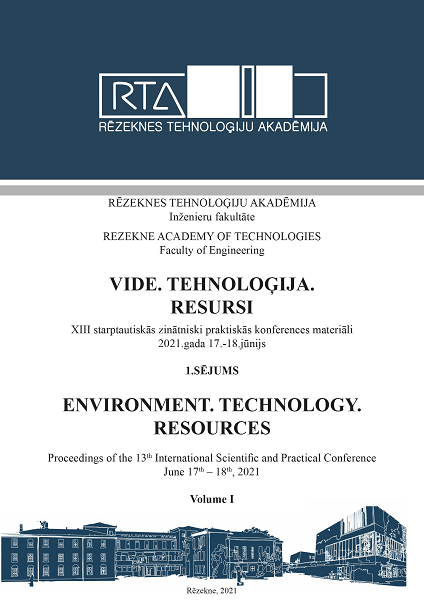ALTERNATIVE UV LIGHT SOURCES FOR SURFACE DISINFECTION
DOI:
https://doi.org/10.17770/etr2021vol1.6596Keywords:
disinfection, UV thallium lamp, UV mercury lamp, UV-C, antiviral, antibacterialAbstract
Mercury UV-C light sources are long known to be efficient for microbial inactivation and have been widely used. At the same time, the radiation, if used in inappropriate doses and spectral regimes, can also cause harmful effects to human tissue. The aim of the study was to evaluate the applicability of the novel UV light sources from thallium – antimony at different UV-C. For the research specially made light sources were produced. The influence of UV-C radiation in the range of 200 - 280 nm was tested on Gramnegative bacterium Escherichia coli, both with mercury and thallium. More than 99.99 % inactivation of E. coli cells was obtained after 10 min contact time for thallium – antimony UV-C light source, demonstrating the potential of the produced lamps.Downloads
References
N.G. Reed, “The history of ultraviolet germicidal irradiation for air disinfection,” Public health rep., vol 125(1), pp. 15-27, Jan-Feb. 2010.
T. Dai, M.S. Vrahas, C. K. Murray, M.R. Hamblin, “Ultraviolet C irradiation: an alternative antimicrobial approach to localized infections?”, Expert Rev Anti Infect Ther, vol. 10(2), pp. 185-195, Feb. 2012.
M. Heßling, K. Hönes, P. Vatter, C. Lingenfelder, „Ultraviolet irradiation doses for coronavirus inactivation – review and analysis of coronavirus photoinactivation studies”, GMS Hyg. Infect. Control, vol.15, 2020, pp. 1-8.
M. Buonanno, G. Randers-Pehrson, A.W. Bigelow, S. Trivedi, F.D. Lowy, H.M. Spotnitz, S.M. Hammer, D.J. Brenner, “207-nm UV light - A promising tool for safe low-cost reduction of surgical site infections. I: In vitro studies”, PLoS One, vol. 8(10), Oct. 2013.
Z. Gavare, A. Svagere, M. Zinge, G. Revalde, V. Fyodorov, Determination of gas temperature of high-frequency low-temperature electrodeless plasma using molecular spectra of hydrogen and hydroxyl-radical. Journal of Quantitative Spectroscopy & Radiative Transfer 113 1676–1682 , 2012
G. Revalde et.all, Use of radiaton sources with mercury isotopes for real-time highly sensitive and selectibve benzene determination in air and natural gas by direct differential absorbtion spectrometry with the direct Zeeman effect, Analytica Chimica Acta 887, 172-178, 2015.
A.A.Ganeev, Z. Gavare, V.I.Khutorshikov , S.V.Khutorshikov, G. Revalde, A.Skudra G.M.Smirnova, N.R.Stankov, High-frequency electrodeless discharge lamps for atomic absorption, Spectrochemica Acta B, Vol. 58, Issue 5, p. 879-889 (2003).
A. H. Malayeri, M. Mohseni, B. Cairns, J. R. Bolton, „Fluence (UV dose) required to achieve incremental log inactivation of bacteria, protozoa, viruses and algae”, IUVA Newa, 2016.
M. Raeiszadeh, B. Adeli, “A critical review on ultraviolet disinfection systems against COVID-19 outbreak: applicability, validation, and safety considerations”, ASC Photonics, Oct. 2020.


